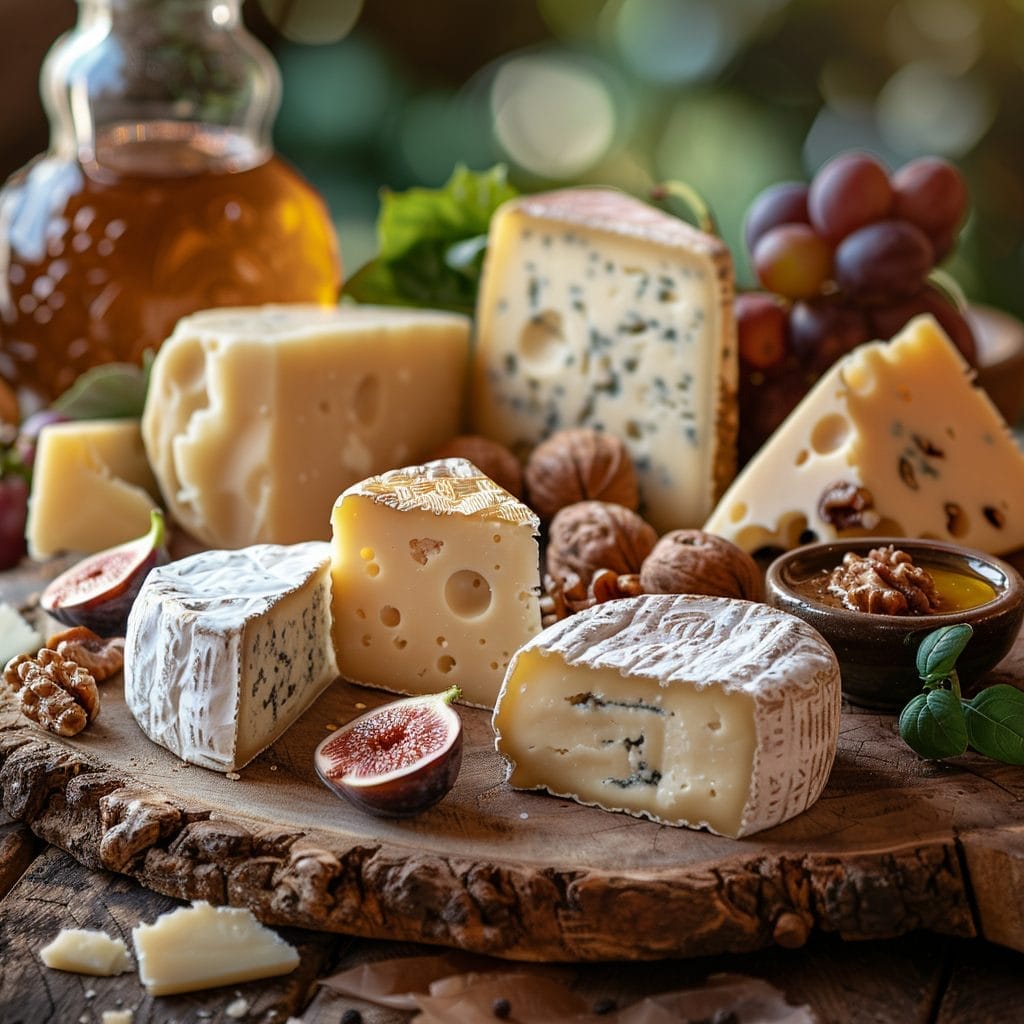Imagine stepping into a bustling Italian market, the air thick with enticing aromas. Amidst colorful stalls and lively chatter, your senses are captivated by an array of Italian cheeses—from crumbly Parmigiano-Reggiano to creamy Pecorino Romano.Each cheese tells a unique story, deeply rooted in Italy’s rich culinary traditions. As a passionate chef, there’s nothing I enjoy more than sharing the intricate flavors of authentic Italian cheeses with fellow enthusiasts.
These cheeses offer more than just taste; they embody the very essence of Italian cuisine. They’re the cornerstone of countless gourmet cheese experiences, heightening the flavors of any dish they’re part of.
In this journey, we’ll explore the distinctive characteristics of these renowned cheeses and uncover hidden treasures from Italy’s diverse cheese heritage. Get ready to discover the secrets that make Italian cheeses irresistible to cheese connoisseurs around the world.
Introduction to Italian Cheeses
Welcome to the mesmerizing world of Italian cheeses, where history, culture, and exquisite flavors blend harmoniously. From ancient times to modern kitchens, Italian cheese history unfolds a rich tapestry of tradition and passion.
The History of Italian Cheeses
The origins of Italian cheese are deeply rooted in antiquity. It is believed that cheese-making in Italy dates back to the Roman Empire, where early forms of Pecorino and Ricotta were crafted.
Over centuries, these traditions evolved, giving rise to a diverse array of cheeses that capture each region’s unique essence.
The Cultural Importance of Cheese in Italy
Cheese is not just food in Italy; it’s a cultural symbol. Italian cheese-making is a cherished aspect of culinary traditions, with regions like Emilia-Romagna and Tuscany taking pride in their local varieties.
Cheese plays a pivotal role in daily meals, celebrations, and festivals, embodying the heart and soul of Italian cuisine.
Popular Uses of Italian Cheeses in Cooking
Italian cheeses are fundamental in cooking, adding depth and flavor to countless dishes. Imagine the umami of Parmigiano-Reggiano shavings on fresh pasta or the creamy melt of Mozzarella on a wood-fired pizza.
Whether sprinkled, melted, or crumbled, cooking with Italian cheeses offers endless culinary possibilities that tantalize the taste buds.
Exploring Parmigiano-Reggiano
Parmigiano-Reggiano, the “King of Cheeses“, is an icon of Italian gourmet cheese. Its production, steeped in tradition, creates a unique flavor that chefs and food lovers everywhere cherish.
The Production Process of Parmigiano-Reggiano
The cheese-making process of Parmigiano-Reggiano is meticulous. Produced in specific regions of Italy, it involves using high-quality milk from select cows. The process includes cooking, curdling, molding, and aging for up to 36 months.
During this time, master cheesemakers oversee every step, ensuring the cheese develops its signature granular texture and rich taste. The dedication to tradition and quality is what makes Parmigiano-Reggiano an unparalleled Italian gourmet cheese.
The Unique Flavor Profile of Parmigiano-Reggiano
The flavor of Parmigiano-Reggiano is unique and extraordinary. It offers a nutty, savory taste with a hint of fruitiness. The texture is firm yet crumbly, with a noticeable crystal-like crunch that aficionados adore.
When grated, it releases aromatic oils that enhance any dish. Whether enjoyed in chunks or freshly grated over pasta, its robust flavor elevates even the simplest of meals.
Cooking Tips Using Parmigiano-Reggiano
Integrating Parmigiano-Reggiano into your cooking can transform ordinary dishes into culinary masterpieces. Here are some practical tips:
- Grate Freshly: For the best flavor, always use freshly grated Parmigiano-Reggiano.
- Pasta Topping: Sprinkle generous amounts over pasta. It adds depth and a deliciously nutty finish.
- Soups and Stews: Stir in small chunks or rinds while cooking to enrich broths and sauces.
- Salads: Create a simple yet elegant salad by shaving thin slices over mixed greens.
These Parmesan cheese recipes will inspire you to experiment and revel in the unparalleled taste of Parmigiano-Reggiano.

The Versatility of Pecorino Romano
Pecorino Romano is a staple in my kitchen. Its sharp, salty flavor can elevate any dish. I love how versatile this Roman cheese variety is.
Differences Between Pecorino Romano and Pecorino Toscano
While Pecorino Romano has a robust, salty profile, Pecorino Toscano is milder with a nutty, almost sweet taste. Both come from sheep’s milk but reflect their respective regions.
- Pecorino Romano: Sharp, aged, and perfect for grating.
- Pecorino Toscano: Mild, soft, and excellent as a table cheese.
Pairing Pecorino Romano with Wine
Finding the right wine for Pecorino Romano is crucial to enjoying its full potential. For Italian cheese pairings, I recommend:
- Chianti: Its acidity balances the saltiness.
- *Barolo:* The tannins complement the cheese’s bold flavor.
These wines enhance the cheese’s taste, making them perfect companions.
Popular Dishes Featuring Pecorino Romano
From pasta to salads, Pecorino Romano fits seamlessly into various dishes. Some of my favorites include:
- *Cacio e Pepe:* A simple yet flavorful pasta dish.
- *Carbonara:* Creamy goodness with a salty kick.
- *Roman-style Artichokes:* The cheese adds depth to this classic appetizer.
Experimenting with these Roman cheese varieties in your meals can be truly rewarding. The next time you’re in the kitchen, don’t hesitate to reach for Pecorino Romano. It’s not just a cheese; it’s a culinary adventure.
The Wide Range of Italian Cheeses
Exploring the vast array of Italian cheese varieties is a culinary adventure. Let’s start with Mozzarella di Bufala; its creamy texture and mild flavor make it perfect for salads and pizzas. The delightful taste makes every bite a joy during a cheese tasting.
Provolone, an Italian dairy product with a semi-hard texture, comes in different stages of aging. The younger Provolone is smooth and mild, while the aged version offers a sharp, tangy flavor. Pairing it with a robust red wine enhances its profile immensely.
Fontina, originating from the Aosta Valley, is another gem. This semi-soft cheese has a nutty, sweet flavor with a buttery finish. It’s ideal for melting, making it perfect for fondues and grilled sandwiches.
Of course, we can only talk about Italian cheeses if we mention Gorgonzola. This blue cheese stands out with its bold, piquant flavor. From creamy spreads to crumbled toppings on salads, Gorgonzola elevates any dish.
Each of these Italian dairy products offers a unique sensory experience. So the next time you’re cheese tasting, don’t just stick to the usual suspects. Delve into the diverse world of Italian cheese varieties and discover new favorites.

Less-Known Italian Cheeses You Must Try
Italy’s rich cheese heritage extends beyond the well-known classics. Let me introduce you to three Italian specialty cheeses that will elevate your culinary experiences.
Discovering Asiago
Asiago cheese, hailing from the Veneto region, offers a delightful spectrum of flavors. When it’s young, it’s sweet and creamy, but as it ages, it develops a sharp, nutty profile.
I love using fresh Asiago in salads and mature Asiago grated over pasta. This versatile cheese can transform even the simplest dishes into gourmet masterpieces.
The Delicacy of Gorgonzola
Gorgonzola is your go-to if you enjoy strong, aromatic cheeses. This blue cheese from Lombardy has a robust flavor, perfect for adding character to sauces, pizzas, and even savory baked goods.
The creamy texture and distinct taste of Gorgonzola make it an essential ingredient in my kitchen.
Hidden Gem: Burrata
Burrata, a true secret treasure of Italian specialty cheeses, combines the best of mozzarella and cream. Its outer shell is mozzarella, filled with a creamy, buttery center that melts in your mouth.
I adore serving burrata drizzled with olive oil and a sprinkle of sea salt or using it as a luxurious topping for fresh tomatoes and basil.
Each of these less-known Italian cheeses, Asiago cheese, Gorgonzola, and Burrata, brings a unique flavor and texture to the table. Explore them, and you’ll find they can quickly become the star ingredient in your favorite dishes.
Conclusion
We’ve journeyed through the rich tapestry of Italy’s cheese world, savoring flavors and delving into traditions. Celebrating Italian cheeses means more than just sampling different varieties; it’s about appreciating the history and culture behind every bite.
Whether you’re an Italian culinary journey enthusiast, a die-hard cheese lover, or someone trying to improve their home-cooked meals, Italian cheeses add unmatched depth and flavor.
From the timeless Parmigiano-Reggiano to the versatile Pecorino Romano and the hidden gems like Asiago and Burrata, there’s always something new to explore.
I encourage you to start your own cheese lovers’ guide and uncover these delightful flavors yourself. Italy’s dedication to cheese-making has gifted us some of the world’s most cherished cheeses, each telling its own story.
Dive in and relish the endless possibilities that come from this incredible culinary tradition.
FAQ
What are some of the most authentic Italian cheeses?
Ah, let me tell you! Parmigiano-Reggiano, Pecorino Romano, Mozzarella di Bufala, Provolone, Fontina, and Gorgonzola make up the heart of authentic Italian cheeses. These are just the beginning of your gourmet cheese experience!
How does the production process of Parmigiano-Reggiano differ from other cheeses?
Parmigiano-Reggiano is a labor of love, crafted with meticulous detail in specific regions of Italy. The milk from cows grazing only on local pastures is used, setting it apart from the rest. The aging process, lasting up to several years, develops its unique nutty, savory flavor and granular texture.
Why is cheese so culturally important in Italy?
Italian cuisine would be unthinkable without cheese! From ancient Roman times to modern-day celebrations, cheese is woven into the fabric of our cultural and culinary traditions. It’s present in everyday meals, grand feasts, and everything in between.
How can I best use Italian cheeses in cooking?
The versatility of Italian cheeses is astounding! Imagine Parmigiano-Reggiano shaved over a steaming plate of pasta, or Mozzarella di Bufala melting perfectly on your pizza. Pecorino Romano adds a punch to salads and pasta dishes alike. Experiment and let these cheeses elevate your everyday meals to gourmet levels.
What sets Pecorino Romano apart from Pecorino Toscano?
Pecorino Romano and Pecorino Toscano offer distinct experiences. Romano is aged longer, resulting in a harder texture and an intense, salty flavor. Toscano, on the other hand, is milder and creamier and can be enjoyed even when fresh. Both are exquisite in their own right, but serve different culinary purposes.
Can you suggest wine pairings for Pecorino Romano?
Absolutely! Pecorino Romano pairs wonderfully with robust reds like Chianti or Montepulciano. The sharpness of the cheese complements the body and tannins of these wines, creating a harmonious balance that will delight cheese connoisseurs and wine lovers alike.
What are some popular dishes featuring Pecorino Romano?
Pecorino Romano shines in classics such as Cacio e Pepe and Carbonara. Its salty, tangy flavor enhances the simplicity of these dishes, turning them into culinary masterpieces. Also, try it grated over roasted vegetables or in hearty soups for an added depth of flavor.
What are some lesser-known Italian cheeses I must try?
If you’re craving something unique, Asiago, Gorgonzola, and Burrata are must-tries. Asiago can range from sweet and creamy to sharp, depending on its age. Gorgonzola’s aromatic and robust nature is a standout, while Burrata offers an unforgettable creamy core wrapped in mozzarella. They’re hidden gems waiting to elevate your culinary adventures!
What cheeses should be included in an Italian cheese tasting?
A well-rounded Italian cheese tasting should include Parmigiano-Reggiano, Pecorino Romano, Mozzarella di Bufala, Provolone, Fontina, and Gorgonzola. Additionally, introduce your palate to lesser-known varieties like Asiago, Burrata, and Taleggio. Each cheese brings a unique flavor and texture to the table, making for an unforgettable tasting journey.

